Elbow
- Anatomy
- Conditions
- Procedures
Elbow Anatomy
The elbow is a complex joint formed by the articulation of three bones –the humerus, radius and ulna. The elbow joint helps in bending or straightening of the arm to 180 degrees and assists in lifting or moving objects.
The bones of the elbow are supported by
- Ligaments and tendons
- Muscles
- Nerves
- Blood vessels
Bones and Joints of the elbow joint
The elbow joint is formed at the junction of three bones:
- The Humerus (upper arm bone) forms the upper portion of the joint. The lower end of the humerus divides in to two bony protrusions known as the medial and lateral epicondyles which can be felt on either side of the elbow joint.
- The Ulna is the larger bone of the forearm located on the inner surface of the joint. The curved shape of the ulna articulates with the humerus.
- The Radius is the smaller bone of the forearm situated on the outer surface of the joint. The head of the radius is circular and hollow which allows movement with the humerus. The connection between the ulna and radius helps the forearm to rotate.
The elbow consists of three joints from articulation of the three bones namely:
- Humero-ulnar joint is formed between the humerus and ulna and allows flexion and extension of the arm.
- Humero-radial joint is formed between the radius and humerus, and allows movements like flexion, extension, supination and pronation.
- Radio-ulnar joint is formed between ulna and radius bones, and allows rotation of the lower arm.
Articular cartilage lines the articulating regions of the humerus, radius and ulna. It is a thin, tough, flexible, and slippery surface that acts as a shock absorber and cushion to reduce friction between the bones. The cartilage is lubricated by synovial fluid, which further enables the smooth movement of the bones.
Muscles of the elbow joint
There are several muscles extending across the elbow joint that help in various movements. These include the following:
- Biceps brachii: upper arm muscle enabling flexion of the arm
- Triceps brachii: muscle in the back of the upper arm that extends the arm and fixes the elbow during fine movements
- Brachialis: upper arm muscle beneath the biceps which flexes the elbow towards the body
- Brachioradialis: forearm muscle that flexes, straightens and pulls the arm at the elbow
- Pronator teres: this muscle extends from the humeral head, across the elbow, and towards the ulna, and helps to turn the palm facing backward
- Extensor carpi radialis brevis: forearm muscle that helps in movement of the hand
- Extensor digitorum: forearm muscle that helps in movement of the fingers
Elbow joint ligaments and tendons
The elbow joint is supported by ligaments and tendons, which provide stability to the joint.
Ligaments are a group of firm tissues that connect bones to other bones. The most important ligaments of the elbow joint are the:
- Medial or ulnar collateral ligament: comprised of triangular bands of tissue on the inner side of the elbow joint.
- Lateral or radial collateral ligament: a thin band of tissue on the outer side of the elbow joint.
Together, the medial and lateral ligaments are the main source of stability and hold the humerus and ulna tightly in place during movement of the arm.
- Annular ligament: These are a group of fibers that surrounds the radial head, and holds the ulna and radius tightly in place during movement of the arm.
The ligaments around a joint combine to form a joint capsule that contains synovial fluid.
Any injury to these ligaments can lead to instability of the elbow joint.
Tendons are bands of connective tissue fibers that connect muscle to bone. The various tendons which surround the elbow joint include:
- Biceps tendon: attaches the biceps muscle to the radius, allowing the elbow to bend
- Triceps tendon: attaches the triceps muscle to the ulna, allowing the elbow to straighten
Nerves of the elbow joint
The main nerves of the elbow joint are the ulnar, radial and median nerves. These nerves transfer signals from the brain to the muscles that aid in elbow movements. They also carry the sensory signals like touch, pain, and temperature back to the brain.
Any injury or damage to these nerves causes pain, weakness or joint instability.
Blood vessels
Arteries are blood vessels that carry oxygen-pure blood from the heart to the hand. The main artery of the elbow is the brachial artery that travels across the inside of the elbow and divides into two small branches below the elbow to form the ulnar and the radial artery.
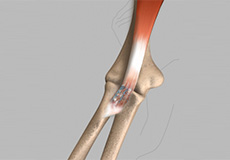
Bicep Tendon Tear at Elbow
The biceps muscle, located in the front of the upper arm allows you to bend the elbow and rotate the arm. Biceps tendons attach the biceps muscle to the bones in the shoulder and in the elbow.
Biceps tear can be complete or partial. Partial biceps tendon tears will not completely break the tendon. Complete tendon tears will break the tendon into two parts.
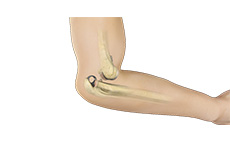
Elbow Dislocation
The elbow is a hinge joint made up of 3 bones – humerus, radius and ulna. The bones are held together by ligaments to provide stability to the joint. Muscles and tendons move the bones around each other and help in performing various activities. Elbow dislocation occurs when the bones that make up the joint are forced out of alignment.
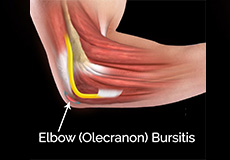
Elbow (Olecranon) Bursitis
The elbow contains a large, curved, pointy bone at the back called the olecranon, which is covered by the olecranon bursa, a small fluid-filled sac that allows smooth movement between the bone and overlying skin. Inflammation of this bursa leads to a condition called olecranon bursitis.
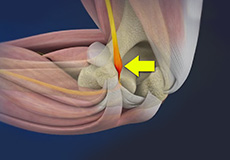
Ulnar Nerve Entrapment (Cubital Tunnel Syndrome)
Cubital Tunnel Syndrome is a condition characterized by compression of the ulnar nerve in an area of the elbow called the cubital tunnel.
The ulnar nerve travels down the back of the elbow behind the bony bump called the medial epicondyle, and through a passageway called the cubital tunnel.
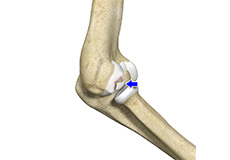
Osteochondritis Dissecans
Osteochondritis dissecans is a joint condition in which a piece of cartilage, along with a thin layer of the bone separates from the end of the bone because of inadequate blood supply. The separated fragments are sometimes called “joint mice”. These fragments may be localized, or may detach and fall into the joint space causing pain and joint instability.
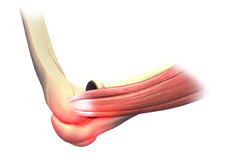
Elbow Sprain
Elbow sprain is an injury to the soft tissues of the elbow. It is caused due to stretching or tearing (partial or full) of the ligaments which support the elbow joint. Ligaments are a group of fibrous tissues that connect one bone to another in the body.

Tennis Elbow
Tennis elbow is the common name used for the elbow condition called lateral epicondylitis. It is an overuse injury that causes inflammation of the tendons that attach to the bony prominence on the outside of the elbow (lateral epicondyle).

Golfer’s Elbow
Golfer’s elbow, also called Medial Epicondylitis, is a painful condition occurring from repeated muscle contractions in the forearm that leads to inflammation and microtears in the tendons that attach to the medial epicondyle. The medial epicondyle is the bony prominence that is felt on the inside of the elbow.

Elbow Injuries
Elbow Fractures: Fracture is a common injury to the elbow. Elbow fractures may result from a fall onto an outstretched wrist, a direct impact to the elbow or a twisting injury. Elbow fractures may cause severe pain, swelling, tenderness and painful movements.If a fracture is suspected, immediate intervention by your doctor is necessary.
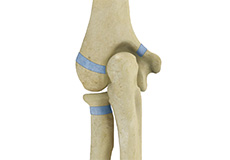
Little League Elbow
Little league elbow also called as medial apophysitis, is an overuse condition that occurs when there is overstress or injury to the inside portion of the elbow. It is commonly seen in children involved in sports activities that require repetitive throwing such as baseball.

Nursemaid’s Elbow
Dislocation of the radius bone present in the elbow is called nursemaid’s elbow. This condition is very common among children below 5 years of age as their bones and muscles are still in the developing stage.

Elbow Pain
The elbow is a hinge joint made up of 3 bones – humerus, radius and ulna. The bones are held together by ligaments to provide stability to the joint. Muscles and tendons move the bones around each other and help in performing various activities. The common causes of elbow pain include:
Fractures/ Injuries
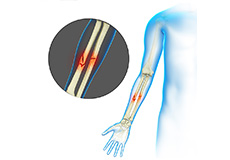
Adult Forearm Fractures
The forearm is made up of 2 bones, namely, the radius and ulna. The primary function of your forearm is rotation i.e., the ability to turn your palm up and down. The fracture of the forearm affects the ability to rotate your arm, as well as bend and straighten the wrist and elbow.
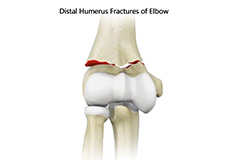
Distal Humerus Fractures of the Elbow
The elbow is a region between the upper arm and the fore arm. The elbow joint is made up of 3 bones. The distal (lower) end of the humerus bone in the upper arm joins with the radius and ulna bones in the fore arm to form the elbow joint.
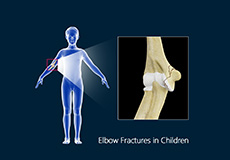
Forearms Fracture in Children
The radius (bone on the thumb side) and ulna (bone on the little-finger side) are the two bones of the forearm. Forearm fractures can occur near the wrist, near the elbow or in the middle of the forearm. Apart from this, the bones in children are prone to a unique injury known as a growth plate fracture.

Elbow Fractures in Children
The elbow is a joint that consists of three bones – the humerus (upper arm bone), radius (forearm bone) and ulna (forearm bone). An elbow fracture most commonly occurs when your child falls on an outstretched arm. It can lead to severe pain in the elbow and numbness in the hand.
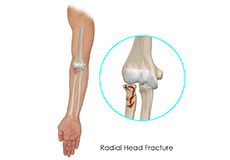
Radial Head Fractures of the Elbow
The elbow is a junction between the forearm and the upper arm. The elbow joint is made up of 3 bones namely the humerus bone in the upper arm which joins with the radius and ulna bones in the forearm. The elbow joint is essential for the movement of your arms and to perform daily activities.
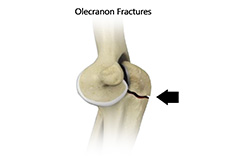
Elbow Fractures
Three bones, the humerus, radius and ulna, make up the elbow joint. Elbow fractures may occur from trauma, resulting from various reasons; some of them being a fall on an outstretched arm, a direct blow to the elbow, or an abnormal twist to the joint beyond its functional limit.
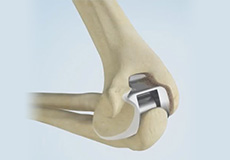
Total Elbow Replacement
Elbow Joint Replacement, also referred to as Total Elbow Arthroplasty is an operative procedure to treat the symptoms of arthritis that have not responded to non-surgical treatments.
The arm in the human body is made up of three bones that join to form a hinge joint called the elbow.
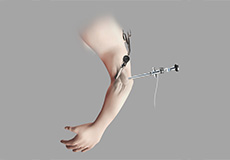
Elbow Arthroscopy
Elbow arthroscopy, also referred to as keyhole or minimally invasive surgery, is performed through tiny incisions to evaluate and treat several elbow conditions.
The Elbow is a complex hinge joint formed by the articulation of three bones - humerus, radius and ulna. The upper arm bone or humerus connects the shoulder to the elbow forming the upper portion of the hinge joint.
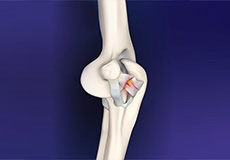
Elbow Ligament Reconstruction
The elbow is a complex joint of the upper limb formed by the articulation of the long bone of the upper arm or humerus and the two bones of the forearm, namely, radius and ulna. It is one of the important joints of the upper limb and is involved in basic movements such as flexion and extension of the upper limb and rotation of the forearm.
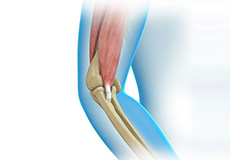
Elbow Tendon & Ligament Repair
The elbow is a complex joint of the upper limb formed by the articulation of the long bone of the upper arm or humerus and the two bones of the forearm, namely, radius and ulna. It is one of the important joints of the upper limb and is involved in basic movements such as flexion and extension of the upper limb and rotation of the forearm.

Elbow Contracture
Elbow contracture refers to a stiff elbow with limited range of motion. It is a common complication following elbow surgery, fractures, dislocations, and burns.


Elbow Instability
The elbow is formed by the junction of the humerus (upper arm bone), and radius and ulna (forearm bones). These three bones articulate to form the elbow joint, which is held and supported by muscles and strong ligaments called the lateral ligament (on the outer side) and ulnar collateral ligament (on the inner side). Injury to these ligaments cause elbow instability and dislocation of the joint.

Triceps Tear Repair
Triceps repair is a surgical procedure that involves the repair of a ruptured (torn) triceps tendon. A tendon is a tough band of fibrous tissue which connects muscle to bone, and works together with muscles in moving your arms, fingers, legs, and toes. The triceps tendons connect the triceps muscles to the shoulder blade and elbow in your arm.

